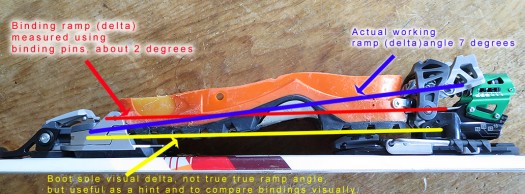For you cliff huckers and World Cup bamboo bashers out there, Dynafit Beast 16 might be the only binding you need. We’ll devote most of this week to the monster grabber since it’s about as different from a normal tech bindings as my ski style is from Queen Elizabeth. I’ll work on our FAQ all week; during each new iteration of the FAQ I’ll publish a brief blog post linking back to the FAQ as it grows. Here goes part one.

What you get visually when you evaluate binding ramp (delta) is different from what you get with a boot in the binding and your foot in the boot. Click images to enlarge.
First installment, Delta Angle (also known as “ramp,” but when referring to binding we call it “delta.” I mixed up a packet of powdered Dynafit Koolaid. As I gulped the purple fluid it spoke to me and said “Low forward-lean angled between front of foot (toe) and heel…=minimal delta. True? The calipers and steel ruler told a tale, and it was good.
Basically, while just about any ski boot results in measurable ramp angle in real life (due to the “boot board” inside the boot raising your heel up), Beast can easily claim to have nearly zero binding delta that would contribute to the overall angle of boot and binding combined. The monster binding also places your boot heel 4 millimeters lower than Dynafit Radical model bindings (though the toe is slightly higher).
For the whole story, see our FAQ. Please leave comments here on this blog post. That way we can keep our comment threads focused on various aspects of Beast. Again, we’ll do a “Week of the Beast” starting today. Stay tuned.
(Please note, Beast ski binding is a radical departure from pretty much all other bindings. At this time we have no idea what kind of commercial success Beast will have, nor what problems may appear once the binding is in full consumer use. These blog posts and FAQs are not a recommendation, they’re simply here to inform anyone interested, and clarify things if you do desire to be an early adopter.)
WildSnow.com publisher emeritus and founder Lou (Louis Dawson) has a 50+ years career in climbing, backcountry skiing and ski mountaineering. He was the first person in history to ski down all 54 Colorado 14,000-foot peaks, has authored numerous books about about backcountry skiing, and has skied from the summit of Denali in Alaska, North America’s highest mountain.
